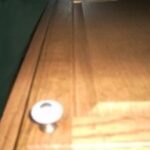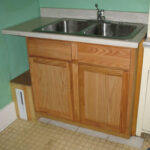Applying an antique finish to a door or cabinet is a fun and easy way of giving a room a new look. Light antique finishes can give a room a genteel cottage chic or beach shack look for those who love delicate, muted colors. For dens, cabins and woodsy hideaways, a darker finish will add a rustic flair.
Complete antique finish kits can be purchased from your local Home Depot or Lowe’s but can also be done using these do it yourself instructions. Before beginning any of these projects, the door will have to be removed and placed on a work table in a well ventilated area, such as in a garage. Door dings and scratches also should be repaired before applying the finish, or can be left alone to add character.
White washing
White washing is a vintage painting technique in which a thin paint was applied to bare wood. In the old days, white wash was made of salt and lime. These days, the look of white wash can be recreated by diluting white latex paint with water in a 4:1 ratio.
For white wash to take, the door should be stripped of the existing paint and lightly sanded before applying the wash.
1. Working one section of the door at a time, use a 3″ brush to apply the whitewash taking care to follow the grain of the wood. Work the paint into the knots and deep grains with the twist of the rag. Let the paint dry for a couple of minutes.
2. Wipe away the excess paint, again following the direction of the wood grain.
3. Repeat these steps on another section of the door, until the entire area has been white washed.
4. Let the door dry for 24 hours before applying a clear sealant to the whitewashed areas.
Antique Glazing
Antiquing is a method of applying an dark glaze over a base coat of paint to simulate aging. While this technique was typically used on furniture, it also looks fantastic when applied to an old paneled & painted door or cabinet front. For this project, you will need a can of antique glaze in a contrast color, lots of soft rags, and a clean brush.
1. Wash the door thoroughly with a degreaser, then rinse and let dry. Wipe down with denatured alcohol and let dry for 24 hours.
2. Once the door has dried, apply the antiquing glaze with a brush. Antique glazing can be a little tricky to work with in that the color sets quickly, and the areas brushed first will retain more of the color than the areas brushed towards the end. For best results, glaze one panel of the door at a time starting with the carved pieces first, and the flat section last.
3. Let the glaze dry until it loses its sheen, and then remove the glaze using soft rags. Start with the flat center pieces of the door panel first, then work out towards the trim pieces, leaving highlights in the crevices of the trim.
4. After the glaze has completely dried, the door can be top coated with a clear sealant.
Crackle paint is another fantastic technique in which a crackle product is used to create that cracked, weathered look of old wood. For this antiquing technique, you will need a brush, a can of semi gloss paint for the base coat, contrast top coat in a matte finish, and a can of Behr’s Crackle #755.
1. Apply the base coat to the door, and let dry for 4 hours.
2. Apply the crackle to the base coat. Keep in mind that the direction of the brush stroke will affect the direct of the crackle.
3. Let the crackle dry for at least an hour, then paint over with the contrast top coat. A lighter top coat application will result in smaller, more delicate crackles while a heavy application of paint will produce heavier cracks.
4. Let the paint dry 24 hours before sealing with a clear coat.
For giving a fresh look to your home, these three techniques are easy DIY projects that can turn those old interior doors into one that has a bit more character.






